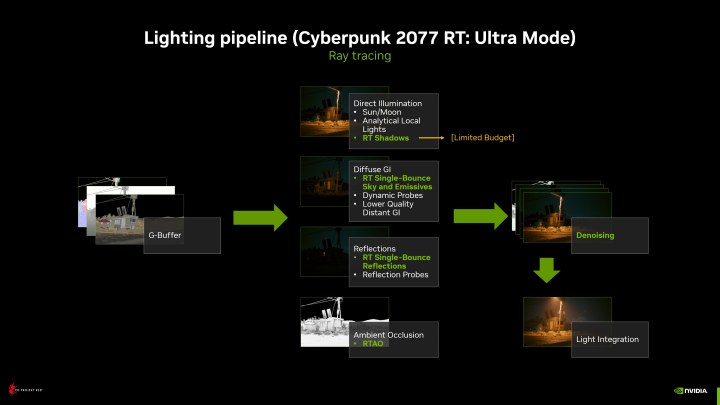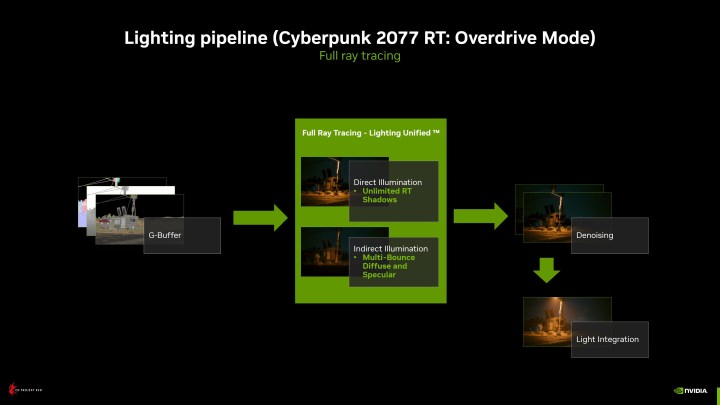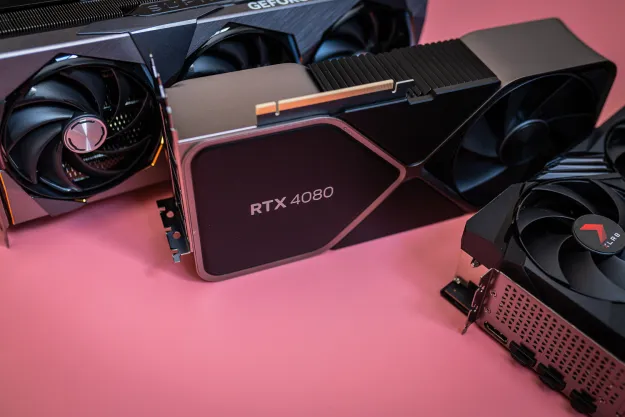Cyberpunk 2077‘s long-awaited Overdrive feature is here. Announced alongside the Nvidia RTX 4090, the new ray tracing mode brings full path tracing to the world of Night City — and it looks incredible. It’s also extremely demanding, and although there’s some argument that the visual improvements are worth it, after testing it myself, the new ray tracing mode doesn’t feel like a reason to go out and buy a new graphics card.
Path tracing is essentially the hard way of doing ray tracing, and it’s only possible now with the immense power of current-gen GPUs and some crafty AI frame generation. So if you don’t have access to the latest and greatest, you can’t turn on the feature. Don’t be worried, though; for as impressive as path tracing is on paper, it doesn’t overhaul the look of Cyberpunk 2077 entirely.
Path tracing isn’t just ray tracing
It’s important to set the scene for how demanding path tracing really is. Path tracing is ray tracing, but it’s a much more strenuous version of ray tracing than what we’ve seen in countless games over the past several years.
Under its basic definition, ray tracing works by following a ray out from your camera. That ray goes throughout the scene, bounces off of objects, and circulates around until it reaches the original light source.
Here’s the trick, though: With the ray tracing you typically see in games, only some of the rays actually matter. They’re calculated — the game only takes a sample of the rays to calculate the final color of the pixel.
Path tracing is the hard way to do things. It’s often called full ray tracing because it takes into account the multiple bounces and surface nuances that traditional ray tracing can’t account for. Developers often find ways to save on performance with traditional ray tracing, too.
As I described in my dissection of Portal RTX, a ray-traced feature like the flashlight in Dying Light 2 saves on performance by not calculating shadows or color reflection properties from the rays.
The effects of path tracing compared to ray tracing aren’t always noticeable, which I’ll dig into next. When the effect matters, though, it really matters. A good example is something like fog, which might not take on color properties in a game with ray-traced reflections and shadows. With full path tracing, the light bouncing around in the fog will take on the color from sources around it.
Before getting deeper, it’s important to point out that the latest update for Cyberpunk 2077 adds much more than path tracing. It sees the introduction of Nvidia’s Deep Learning Anti-Aliasing (DLAA), along with Intel’s XeSS Super Resolution feature. The update also overhauls the benchmark screen, now displaying system specs, driver version, and more.
Not always easy to spot

It’s not always easy to spot the differences between ray tracing and path tracing. In a big outdoor scene like the one above, for example, there are only minor differences between the ray-traced and path-traced versions.
In the path-traced version (left), there’s slightly less reflection of the trees above as the puddles get closer to your character. Compare that to the ray-traced version (middle) where you get the infamous shiny surface effect.
At first glance, the image without ray tracing (right) actually looks a bit better — the reflections are sharper and the color is more moody. There are some trade-offs, though. Unlike the ray-traced and path-traced versions, the reflections of the trees are cut off because they aren’t visible to the camera, and there isn’t bloom from the large purple lights.

Those small differences can matter, as evidenced by the comparison above. Without ray tracing (right), the large lights on the right don’t reflect off the stone pillars. There are some other notable differences between path tracing and ray tracing here, too.
The shadow cast by the ledge above is much less noticeable in the path-traced version (left). Instead, the overwhelming power of bright sunlight washes out the shadow like it would in the real world.

And similarly, in the scene above, the shadows are much less intense in the path-traced version (left). Instead, objects like the bench take on more natural shadowing. This is particularly true with the light right next to bench. Without ray tracing (right), there’s a stark direct reflection on the bench. With both ray tracing and path tracing, though, that reflection is swallowed up by the much brighter light from the sun. This image is also a good illustration of what path tracing can do for shadows (look at the trees in the background).
In my time with the new path tracing mode, interior scenes stuck out the most. This is where path tracing really shines over ray tracing. Comparing the two, you can see the reflection on the ceiling barely registers with ray tracing, while it nearly blows out the scene with path tracing.
Similarly, the reflection off the ground isn’t present, and you don’t get that subtle blend of the white and red lights mixing together on the floor.
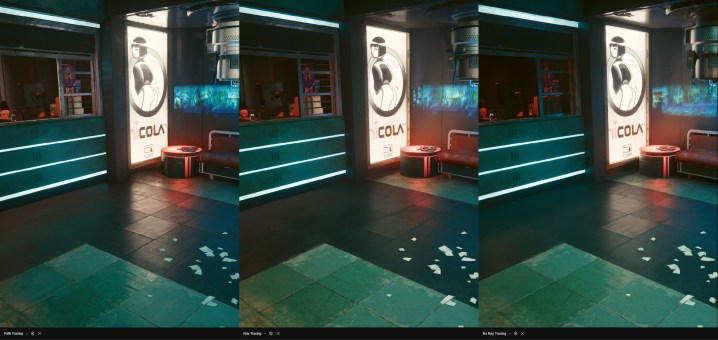
If you look at the version without ray tracing (right), you get a lot of the reflections that are present in the path-traced version (left). The devil is in the details here, though. The bench doesn’t take on any of the red reflections from the table next to it, and the backwall doesn’t reflect the large white light. In addition, the counter is covered in shadow, rather than being lit up by the open doorway that’s just off camera.
That’s the power of path tracing. It’s remarkable when you can spot the nuances of lighting in a scene and see how this expensive technique can elevate the look.
There’s the problem, though; path tracing is expensive. For as good as it can look, the differences between path tracing and even traditional screen space techniques can be tough to spot in normal gameplay, and turning on path tracing can vastly reduce your performance.
Nothing comes free

You may not want to turn on path tracing for the performance hit, but there’s a good chunk of people who simply shouldn’t turn on path tracing. Cyberpunk 2077‘s path tracing works best on RTX 40-series graphics cards, so you should have at least an RTX 4070 Ti to turn it on. It technically works on the RTX 3090 as well, though the developer says that you should expect the game to run at 30 frames per second (fps) at 1080p. With other GPUs, good luck.
I tested path tracing out with the RTX 4090 and Intel’s Core i9-13900K, which is, by nearly any metric, the most powerful gaming PC money can buy right now. Going from the highest preset without ray tracing to path tracing dropped my frame rate from 118 fps to 31.4 fps — a 74% dip.
Even with the highest ray tracing preset, you can comfortably play the game at 60 fps. Also keep in mind that I was testing on an Alienware 34 QD-OLED monitor with a resolution of 3,440 x 1,440. At 4K, the game is even more demanding.
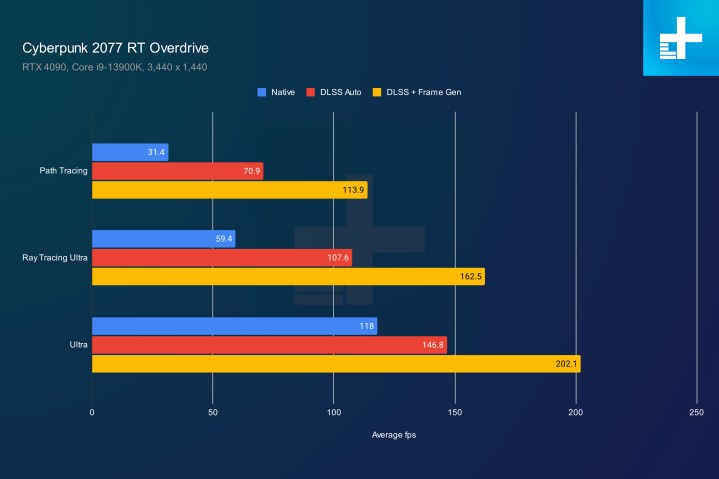
You’re not supposed to use path tracing like this, though. There’s a reason that you need an RTX 40-series GPU, and that’s DLSS Frame Generation. It’s no coincidence that DLSS Frame Generation boosts performance to around the same level as native performance without ray tracing. Sure, turning on DLSS without ray tracing results in even higher performance, but at around 120 fps? That’s not bad for one of the most demanding games a PC can run right now.
If you have one of the best graphics cards on the market, Cyberpunk 2077‘s Overdrive mode is a great way to elevate the look of the game. As my testing and images show, though, it’s not a revolution. It’s still very demanding, locking out a large swath of otherwise powerful hardware, and although it looks the best, the differences are sometimes tough to spot.
So, turn on Overdrive if you can. But don’t worry if you can’t; you’re not missing out on much.
Editors' Recommendations
- The RTX 4090 is more popular on Steam than any AMD GPU
- New Nvidia update suggests DLSS 4.0 is closer than we thought
- Why you shouldn’t buy the best GPU of last year
- To celebrate its milestone, here are the best (and worst) examples of RTX in games
- Brighter isn’t better for OLED monitors. An expert told me the surprising reason why

